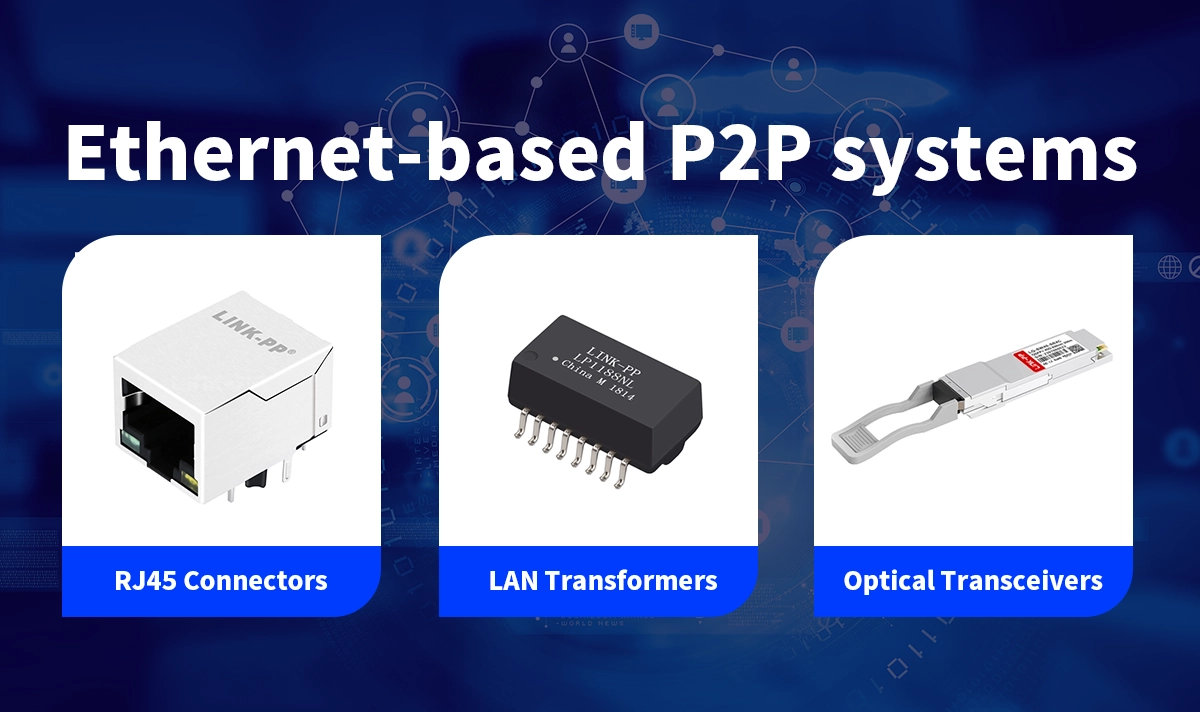
✅ What Is a Point-to-Point Network?
A Point-to-Point (P2P) network architecture is the simplest form of network topology, creating a dedicated communication link between two nodes—usually a sender and a receiver. Unlike shared or broadcast networks, a P2P link reserves the entire communication channel for just these two endpoints, delivering low latency, high reliability, and secure data transmission.
Modern P2P links serve as the backbone of high-speed Ethernet connections, fiber-optic communication systems, and data center interconnects. They are commonly used for direct device-to-device communication between routers, switches, servers, and optical modules, supporting both copper and optical media. High-performance components such as LINK-PP RJ45 connectors ensure signal integrity and mechanical stability in copper-based links, while LINK-PP optical transceivers enable long-distance, high-speed data transfer over fiber, making P2P connections robust and reliable.
✅ How Point-to-Point Architecture Works
In a P2P network, data travels directly between two devices without intermediate nodes. Connections can be wired—using twisted-pair cables or fiber-optic links—or wireless, employing microwave or laser technologies.
For Ethernet-based P2P systems:

RJ45 connectors provide the physical interface for copper links, supporting 10/100/1000Base-T and 10GBase-T connections.
LAN transformers maintain signal quality by suppressing noise, providing isolation, and matching impedance.
Optical transceivers, such as SFP, SFP+, or QSFP modules, convert electrical signals into optical signals, allowing high-speed communication over longer distances.
By integrating these high-quality components, P2P networks achieve minimal interference, reduced transmission errors, and consistent low-latency performance, which is essential for mission-critical environments like data centers, industrial automation systems, and telecom networks.
✅ Applications of Point-to-Point Networks
Data Centers
P2P links connect servers, switches, and storage systems using high-performance RJ45 connectors and optical transceivers, ensuring uninterrupted data flow and low latency.
Telecommunication Systems
Fiber-based P2P connections between wireless base stations, backhaul networks, and metro Ethernet links rely on optical transceivers for high-speed and stable communication.
Industrial and Embedded Systems
Automation equipment, IoT gateways, and embedded controllers use copper Ethernet interfaces with integrated RJ45 connectors for reliable real-time data exchange.

✅ Advantages of Point-to-Point Networks
High Performance: Dedicated bandwidth ensures consistent throughput without contention.
Low Latency: Direct connections reduce processing and switching delays.
Enhanced Security: Data travels on a private link, lowering the risk of interception.
Simplicity: Easier to configure and troubleshoot compared to complex topologies.
These features make P2P the preferred choice for network segments that demand deterministic performance, signal stability, and high-speed data transfer.
✅ P2P vs. Point-to-Multipoint and Multipoint-to-Multipoint
Point-to-Point (P2P), Point-to-Multipoint (P2MP), and Multipoint-to-Multipoint (MP2MP) represent fundamentally different ways of structuring network connections, each optimized for specific communication needs.
P2P links create a dedicated, direct connection between exactly two nodes, offering maximum bandwidth efficiency, low latency, and high security, making them ideal for critical data exchanges or backbone interconnections.
In contrast, P2MP connects a single central node to multiple endpoints, enabling one-to-many communication while sharing bandwidth across the endpoints, commonly used in wireless access networks, fiber-to-the-home (FTTH) deployments, or base station backhauls.
MP2MP networks, on the other hand, allow multiple nodes to communicate with multiple other nodes in a flexible mesh-like structure, supporting dynamic routing and resilient paths, which is essential for collaborative applications, distributed computing, and modern ad-hoc or wireless mesh networks. Each topology balances trade-offs among complexity, scalability, cost, and performance, influencing design choices based on traffic patterns, reliability requirements, and deployment scenarios.
✅ Conclusion
Point-to-Point network architecture represents the foundation of high-speed, reliable communication. Whether deployed in Ethernet LANs or optical transmission systems, integrating components like LINK-PP RJ45 connectors, LAN transformers, and optical transceivers empowers engineers to build deterministic, low-latency P2P networks that meet the demands of modern data infrastructure.


